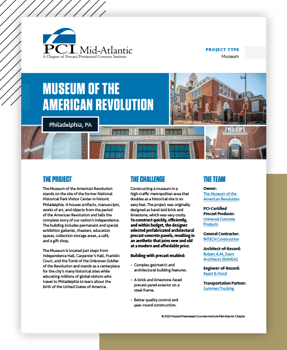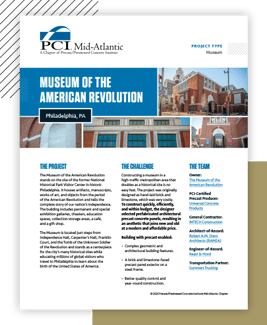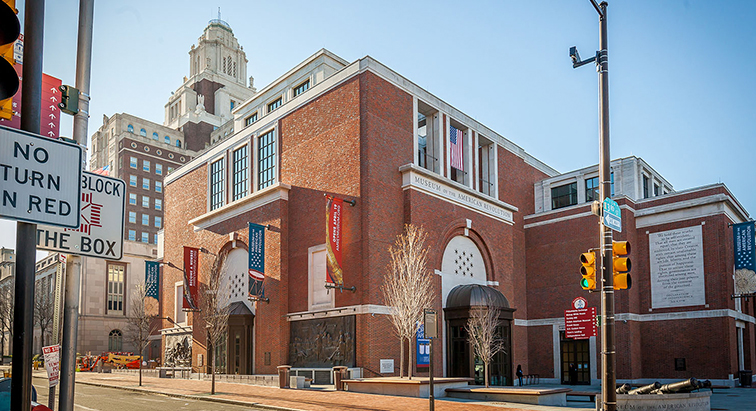Case Study: The Museum of American Revolution
The Museum of the American Revolution stands on the site of the former National Historical Park Visitor Center in historic Philadelphia and is located just steps from Independence Hall, where it stands as a centerpiece for the city’s many historical sites. The Museum includes permanent and special exhibition galleries, theaters, education spaces, collection storage areas, a café, and a gift shop. To construct quickly, efficiently, and within budget in a tight metropolitan area, the museum partnered with PCI-certified precast producer Universal Concrete Products to construct the new building with prefabricated architectural precast concrete panels, resulting in an aesthetic that joins new and old at a modern and affordable price. Architectural precast concrete delivered construction site efficiencies, fulfilled every design goal, and contributed to many environmental aspects of the project.
The Producer
- PCI-Certified Precast Producer:
Universal Concrete Products
Stowe, PA
- Owner:
Museum of the American Revolution
Philadelphia, PA
- General Contractor:
INTECH Construction
Philadelphia, PA
- Architect:
Robert A.M Stern Architects (RAMSA)
New York, New York
- Engineer-of-Record:
Keast & Hood
Philadelphia, PA - Transportation Partner:
Summers Trucking
Ephrata, PA
Download the Case Study to see how Universal Concrete Products mimicked a hand-laid brick and limestone façade with architectural precast concrete to save time and money while constructing a striking museum with complex architectural and geometrical pieces in a constrained, historical area.
 What’s Inside:
What’s Inside:
- The project’s key details, including the scope, team members, and challenges
- The solution that allowed for matching design intent while leveraging offsite precast prefabrication
- The results that married historical inspiration with modern efficiency
Architectural precast concrete not only offered design flexibility for architectural expression, but also contributed to the durability, sustainability, energy efficiency, and low maintenance of the building. At the same time, the plasticity of precast concrete allowed for a high level of design detail and character that couldn’t be matched by other materials due to cost and time constraints.
Explore the resources below to discover how precast provides aesthetic versatility, speedy construction, and low-maintenance benefits for a range of buildings, including museums, schools, offices, theaters, stadiums, and more. See if it can improve the design of your next project.
- Member Spotlight — Universal Concrete Products
- Blog: Precast Concrete Earns an A+ for K-12 School Construction
- Guide: The General Contractor's Guide to Precast Concrete
- Earn Continuing Education Credit On Demand Now! Precast Concrete Systems in Mixed-Use Parking Applications
ACHIEVE MORE WITH PRECAST

The Museum of the American Revolution serves as an excellent example of a complex architectural precast project completed by a PCI AA-certified plant. Precast concrete also contributed to sustainability goals; The Museum is a LEED Gold certified building, and a resilient, low-maintenance structure. Architectural precast enabled building complex geometry and architectural features, replaced hand-laid brick and limestone, and provided the designers better quality control and year-round construction.
Keep precast concrete and the Mid-Atlantic region's precast businesses in mind for your next project. Find helpful design tools, project resources, and detailed information on working with precast in our comprehensive Solutions Center.







